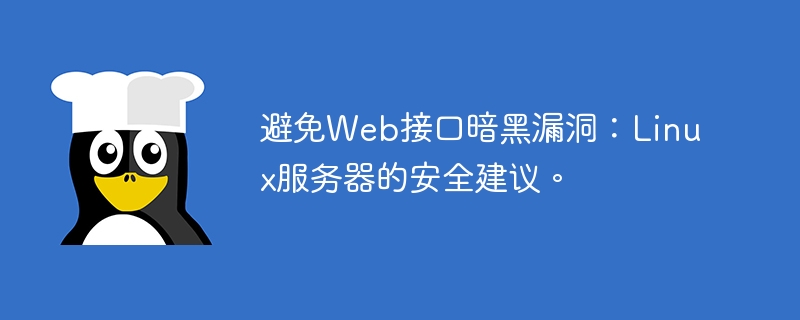

Avoiding Web Interface Dark Vulnerabilities: Security Suggestions for Linux Servers
As an important part of modern technology, Web interfaces not only provide us with convenience, but also bring Security Risk. On a Linux server, it is crucial to secure the web interface. This article will introduce some security recommendations to avoid web interface dark vulnerabilities on Linux servers.
Regularly updating the system and software of the Linux server to the latest version is the first step to improve security. New versions usually fix known vulnerabilities and security issues. Using package management tools to automatically update systems and software can reduce human error.
Using strong passwords is the basis for protecting the web interface. A strong password should include letters, numbers, and special characters and be at least 8 characters long. Avoid using passwords that are easy to guess, such as birthdays, phone numbers, etc.
Ensure that the web interface uses the HTTPS protocol so that the transmitted data is encrypted. HTTPS uses the SSL/TLS protocol to encrypt data and protect users' sensitive information from being stolen or tampered with.
Configuring the firewall of the Linux server is an important measure to protect the Web interface. Firewalls filter inbound and outbound network traffic to prevent unauthorized access. Only open necessary ports and limit the sources of network access.
Disabling unnecessary services and functions on the Linux server can reduce the attack surface. Carefully review running services and features and turn off or uninstall unnecessary components as needed.
Ensure that the permissions of files and directories used by the web interface are set appropriately. Only users or processes that need to read or write can access related files and directories. Use the chmod command to set appropriate access permissions, and regularly audit and update permission settings.
The configuration file of the Web interface contains many important parameters and settings. Make sure that the configuration file's permissions are set to only allow access to the required users or processes. At the same time, review the configuration file and ensure that key parameters are correctly set, such as login restrictions, session expiration time, etc.
Setting login restrictions for the web interface is a necessary measure to prevent dark vulnerabilities. Set a limit on the number of failed logins and temporarily lock the account when the limit is reached. This prevents brute force attacks.
Regularly check the log files of the Web interface and monitor abnormal behaviors. Abnormal login attempts, illegal access, etc. may be signs of a Dark vulnerability attack. Enable appropriate log levels, set alert rules, and promptly respond to and investigate abnormal behavior.
Regularly back up the data and configuration files of the web interface and save them in the offline device. In this way, even if a security incident occurs, services can be restored in time and the integrity of user data can be protected.
To sum up, protecting the security of the Web interface on a Linux server requires the comprehensive use of a variety of measures and tools. Always keep systems and software updated, use strong passwords and encryption protocols, configure firewalls and disable unnecessary services, limit file and directory permissions, use secure configuration files, set login restrictions, monitor logs and abnormal behavior, and perform regular backups and recovery. By implementing these security recommendations, we can reduce the risk of web interface dark vulnerabilities and protect the security of servers and users.
If the text exceeds 1500 words, you can add some cases and detailed explanations yourself.
The above is the detailed content of Avoiding Web Interface Dark Vulnerabilities: Security Tips for Linux Servers.. For more information, please follow other related articles on the PHP Chinese website!
 windows cannot open add printer
windows cannot open add printer what is search engine
what is search engine Regular expression usage of arbitrary characters
Regular expression usage of arbitrary characters The difference between while loop and do while loop
The difference between while loop and do while loop Bitcoin historical price chart
Bitcoin historical price chart The difference between wildcard masking and unmasking
The difference between wildcard masking and unmasking The difference between external screen and internal screen broken
The difference between external screen and internal screen broken What are the java workflow engines?
What are the java workflow engines?



